It was a life-changing experience that gave me time to really come to realize what things are important to me and what I want my priorities to be. Stewart Sarris, Southwest Semester alum.
The 50-day Southwest Leadership Semester journeys through mountains, canyons, deserts and rivers by way of rafting, canyoneering, backpacking and kayaking, in one of the most geologically stunning landscapes in the world. As Utah’s landscape flows freely from canyons to rivers to desert, so do the components of the course; which are designed to encourage leadership, compassion, technical skills and a personal strength you might not have known you had.
Intrigued? Learn more as we break down the components* of the Southwest Leadership Semester that take you though this unique expedition:
1. Course Start and Rafting on the San Juan River
The Southwest Leadership Semester begins by heading straight into the canyons and rivers that you’ll call home for the next 50 days. After learning basic travel and camping techniques such as Leave No Trace, map and compass navigation, camp craft and first aid, you’re ready to embark on your first adventure- a rafting trip on the San Juan River.
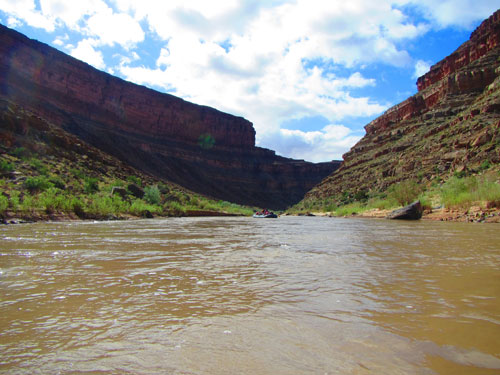
Rafting on the San Juan River. Photo by KT Gianoulias
Rafting: While on the river, each day is spent learning to recognize and navigate various obstacles and hazards, and how to anticipate the forces of the current upstream. You and your companions work to become a team, coordinating your spacing and paddle strokes. You will have an opportunity to be the captain of your crew and put to use what you’ve learned as you maneuver your raft through Class II – IV rapids. Interspersed between the rapids are flat-water sections that can last for a full day where there is a current, but no whitewater. Time in a raft is ideal for getting to know each other and forming boat pride, laughing your way downriver as you relax into the simplicity of river life.
I loved seeing the beauty of the natural world around me, hiking and rafting through beautiful areas of untouched wilderness. Stewart Sarris, alum
In places, the canyon rims rise thousands of feet above, enclosing you in a remote world of rushing water, delicate ecosystems, and unbelievable beauty. During your course, your Instructors will introduce you to the most important elements of the river life: reading whitewater currents, paddling, whitewater captaining, geology of the canyon, environmental stewardship, outdoor cooking, natural history of the river canyons, and of course, the beautiful star-studded night skies.
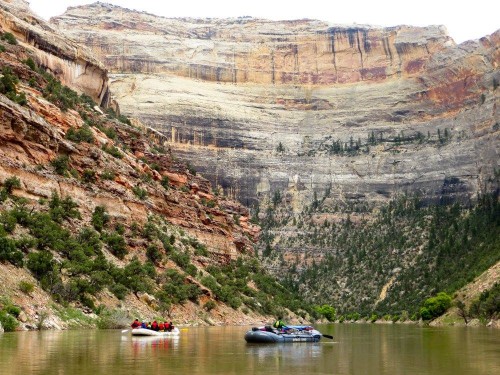
Rafting through the canyons in the Southwest.
The San Juan River is a major tributary of the Colorado River, flowing 83 miles through the deeply incised sandstone of the Colorado Plateau. The river is world-renowned for archaeological sites of ancient Indians featuring both petroglyphs and cliff dwellings accessible from the river. The San Juan River is also well known for its exquisite natural scenery, as you’ll soon find out once you are deep within the towering canyon walls.
2. Technical Canyoneering in Canyon Country
As your first rafting section comes to an end, you and your crew will journey through the intriguing Canyon Country, taking in the infinite shapes of the arches, towers, buttes, amphitheaters, overhangs, and domes. Along the way, you will learn how to negotiate through slick rock, navigate with maps, find water, and live comfortably in the canyons.
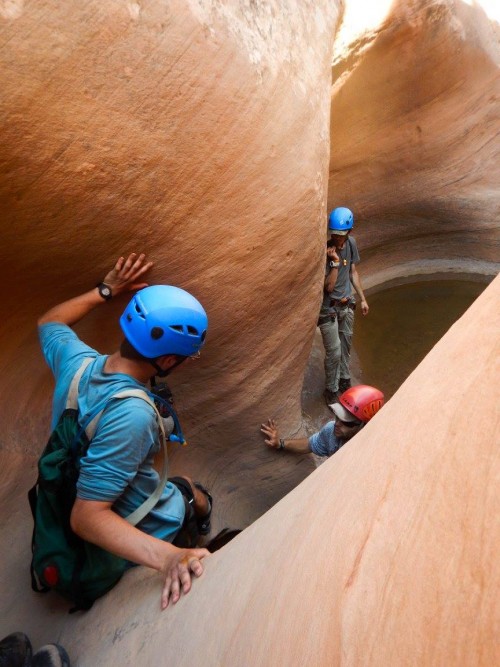
Exploring the canyons in Canyon Country. Photo by Kelly Crandall
Technical Canyoneering: Canyoneering involves exploration and travel in canyons that are often narrow, sinuous and steep. Traveling through them requires a combination of scrambling over boulders, rappelling, lowering packs, and hiking. This rugged, rocky terrain requires teamwork and delicate decision-making amongst the crew.
To meet the demands of the technical terrain you will encounter, Instructors begin by teaching the foundational skills necessary for efficient travel, such as basic movement over rock and spotting techniques. Instructors then move on to more advanced movement on rock and roped techniques such as rappelling, knot-tying, self-rescue and rope handling. These skills will then be put into use when the terrain becomes more challenging.
I had so much fun with the technical aspects of the canyons. That enjoyment was amplified by the thought it took to get our whole group through, given our varied skill and comfort levels. Elisabeth Tilstra, alum
Canyon Country, Utah: Canyon Country is made up of a vast network of canyons, formed by millennia of wind and water erosion. The canyonlands of Southern Utah are still as stunning, mysterious, and wild as they were for the Ancestral Puebloan and Fremont Indians who roamed these lands over 800 years ago. The sandstone canyons are a geological playground composed of alcoves, fins, pinnacles, buttes, towering walls, ledges, cliff dwellings, and arches just waiting to be explored.
3. Whitewater Rafting & Kayaking in Desolation Canyon
As you emerge from the canyons you and your crew will step onto kayaks and rafts in Desolation Canyon. Your experience predicting whitewater and hydrology from the last river section will be easily applied to this smaller, more responsive watercraft. During your kayaking lessons, you will learn new skills such as eddy turns, bracing, surfing, and self-rescue. With these boats, everything depends on you: your effort, your planning, and your decisions. As you travel close together with your crew, each day will bring a new level of confidence and greater sense of accomplishment.
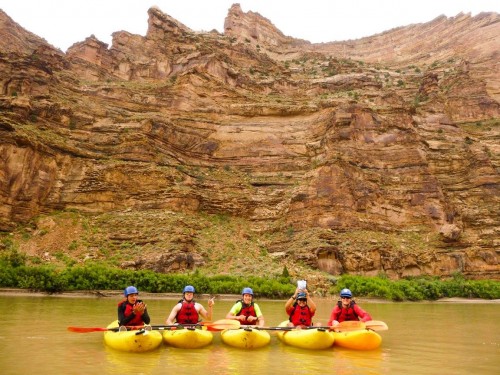
Kayaking in Desolation Canyon.
Desolation Canyon on the Green River, Utah: When legendary outlaw Butch Cassidy and his Wild Bunch gang needed to escape from the eyes of pursuing posses, they would head to the vast and beautiful wilderness of Desolation Canyon. Midway through its journey through Utah, the Green River flows through Desolation Canyon, a truly wild location where spectacular rock formations, ancient rock art, and abandoned 19th century ranches await explorers. At its greatest depths, Desolation Canyon plunges to carve a gorge deeper than the Grand Canyon.
4. Whitewater Rafting & Hiking in Cataract Canyon
From Desolation Canyon, you and your crew will journey into the heart of Canyonlands National Park by way of the famed Cataract Canyon. You will learn how to guide a whitewater raft as you float past natural wonders and ancient ruins to the confluence of the Colorado and Green Rivers, while preparing for what awaits downstream.
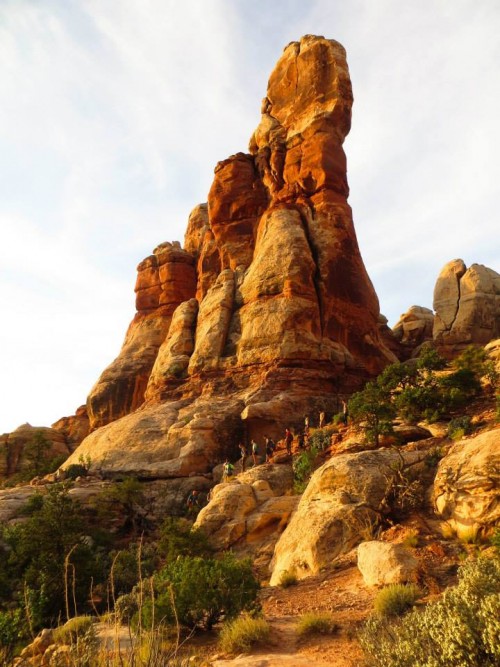
Students explore the unique rock formations while in Cataract Canyon. Photo by Dylan Marks
Cataract Canyon on the Colorado River: The Colorado River roars through 29 exciting rapids that rate with those of the Grand Canyon in power and difficulty, including the famous Mile Long Rapids and “the Big Drops.” In the nearby canyons, fantastic rock shapes carved by forces of nature await you as your group ventures off river to explore these jaw-dropping views.
5. Canyon Backpacking in Dark Canyon Wilderness Area
You and your crew then head back into the canyons to explore Dark Canyon Wilderness Area. You will journey through this intriguing canyon with only your backpack, stocked with everything you need to thrive in the wilderness.
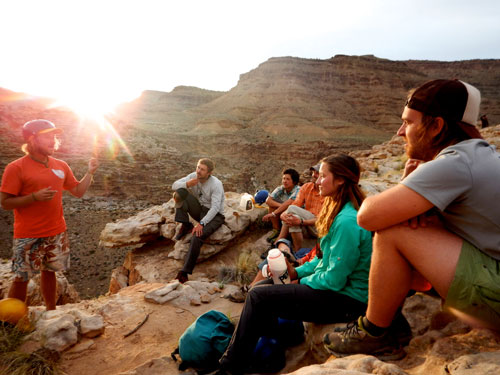
An Instructor gives a lesson amongst the canyons. Photo by Kelly Crandall
Canyons carve their way to depths of over 1,000 feet to capture your sense of awe and envelop you in wonder. As you find yourself at the bottom of the majestic canyon with your toes dug into warm sandy beaches, you will be surrounded by lush, green cottonwood trees and crystal clear waterfalls that pool into deep swimming holes.
It was an awesome time with some awesome people living simply in some crazy places doing some crazy and exhilarating things. It was hard, but I’d do it again in a heartbeat. Not too many words can describe what we’ve all been through. Briege Keenan, alum
Dark Canyon Wilderness Area: Dark Canyon is a truly wild place with many mysteries yet to be uncovered. The landscape is filled with rock that has been eroded into an endless variety of mesas, towers, grottos, watersprings, and canyons.
6. Service Project
Between rafting down world-class rapids and backpacking though geological wonders, you and your crew will take a few days to help out the community. This service project will either be community-based – helping people who live in the area – or environmentally-based; working with land managers (US Forest Service, Bureau of Land Management, National Park Service, local land trusts, etc.) to restore or improve our wild and wonderful public lands. Past projects have included working at a local community youth garden, trail building, natural building techniques for affordable housing initiatives, and naturalizing open space by cleaning up trash and debris.
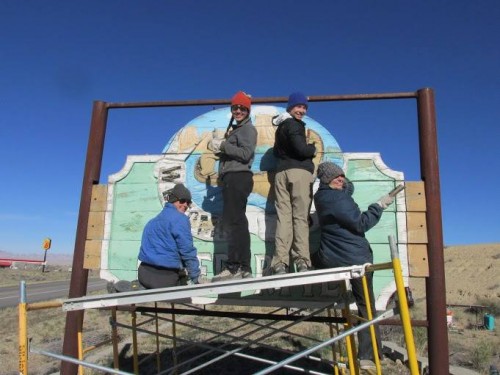
Student complete their service project in Utah.
7. Final Challenge Event
As your 50-day expedition comes to an end, it is time to put your new skills to the test during the Final Challenge Event. There are no “set in stone” final challenges, as each challenge throughout course has been tailor fitted to the current conditions and participants, but it may take the form of a run or team challenge amongst many options. This event is your personal challenge to finish successfully and with style, by embodying all the lessons you have learned during your Outward Bound course. You may be surprised by how far you have come in 50 days and how far you can go.
50 days of laughs, adventures, new friends, new found respect for myself and others make up the sum of events that have changed my life. Justin Allison, alum
Ready to explore and develop skills in one of the most unique landscapes in the world? Learn more about the Southwest Leadership Semester here and save your spot on our next course.
Planning a gap year? Secure a semester with any of our longer expeditions, offered throughout the year in a variety of wild and beautiful places. To view all of our semester options, visit our Course Finder.
*Please note, specific course plans will vary according to weather, student skills and abilities, and instructor preferences




